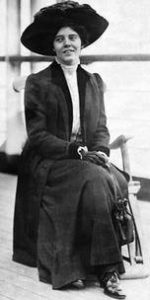
Today in Feminist History is our daily recap of the major milestones and minor advancements that shaped women’s history in the U.S.—from suffrage to Shirley Chisholm and beyond. These posts were written by, and are presented in homage to, our late staff historian and archivist, David Dismore.
January 20, 1910: Alice Paul returned to her family’s home in New Jersey today after an extended stay in Great Britain.
Though she is planning on giving a high priority to her studies at present, she still seems quite dedicated to the cause of woman suffrage, and will surely be making more contributions to the “Votes for Women” campaign before too long.
Paul went to England in 1907 to study social work, and while there, just happened to be walking by when Christabel Pankhurst was speaking, or at least trying to speak, to a loudly jeering street corner crowd. Afterward, Paul introduced herself to the speaker, who is the daughter of Emmeline Pankhurst, England’s most radical “suffragette,” and Paul soon joined in the activities of their Women’s Social and Political Union.

British women who engage in traditional, peaceful means of securing the vote refer to themselves as “suffragists,” and though the word “suffragette” was originally coined by London’s Daily Mail as a derogatory term, the militant members of the WSPU have adopted it, and use it as a way of distinguishing themselves from their more moderate colleagues in other groups.
Believing in deeds, not words, the organization has engaged in a variety of radical actions, escalating from heckling to rock throwing and window smashing. It was heckling that got Alice Paul tossed into London’s Holloway Jail—when, in November of last year, she and another woman snuck into the Guild Hall early one morning disguised as scrubwomen, and when Prime Minister Asquith made a short pause during a speech, interrupted him.
As she explained today: “I did not throw a stone. I simply rose in the gallery and shouted ‘Votes for Women!’ In the prison it was horrible. I had been arrested twice before, once in Scotland and once in London, simply for refusing orders to ‘move on’ at political meetings. I was released after five days’ imprisonment in Scotland and three weeks in London because I refused food. Those were recognized tactics among the suffragettes. Last October, the custom of forcible feeding was introduced, and I was one of the victims of the practice.”
She served her full 30-day sentence for the heckling and was released on December 9th, after twice-daily force-feedings by prison officials beginning on November 11th. During her stay in England she met another American, Lucy Burns, in a police station after both had been arrested, and they have now become good friends. So, one by one, some Americans are being converted to more radical tactics.
These methods are quite effective, according to Paul: “The militant policy is bringing success… the agitation has brought England out of her lethargy, and women of England are now talking of the time when they will vote, instead of the time when their children would vote, as was the custom a year or two back.”
Though still dominated by the National American Woman Suffrage Association, the American suffrage movement is becoming more diverse and assertive as well. Part of the change may simply be due to the passing of first-generation suffrage icons such as Elizabeth Cady Stanton in 1902 and Susan B. Anthony in 1906.
But there are also many new groups, such as the Progressive Woman Suffrage Union, 24 of whose members staged an unprecedented, and at the time highly controversial, “suffrage parade” in New York City on February 16, 1908 in courageous defiance of propriety – and the police. There is talk of repeating that well-publicized spectacle this spring, with the Equality League of Self-Supporting Women, led by Harriot Stanton Blatch, Elizabeth Cady Stanton’s daughter, organizing it this time, and on a larger scale.
Even the very symbol of British militance, Emmeline Pankhurst, came to the U.S. for a visit at Blatch’s invitation, and she spoke to a sold-out house at Carnegie Hall on October 25th, making it the largest suffrage gathering in U.S history. Also in October, Carrie Chapman Catt formed the Woman Suffrage Party of Greater New York, which will work along overtly political lines to bring about woman suffrage in the Empire State.
The National American Woman Suffrage Association is busy in its own non-militant way as well, and is currently in the process of gathering a million signatures to be delivered to Congress demanding passage of the Susan B. Anthony (woman suffrage) Amendment to the U.S. Constitution, which would ban sex discrimination at polling places nationwide.
New tactics, such as frequent street-corner meetings in which women speak to large crowds of men are now regular activities among the younger and more radical suffragists, and are gradually becoming accepted by the public. Should Alice Paul become a full-time suffragist again after she finishes her studies, and if her friend Lucy Burns returns to the U.S. from her current suffrage work in Scotland, things could get a lot more lively here. Since women vote in only 4 of the 46 States, and the most recent victory was won in 1896, more militance can certainly be justified.





